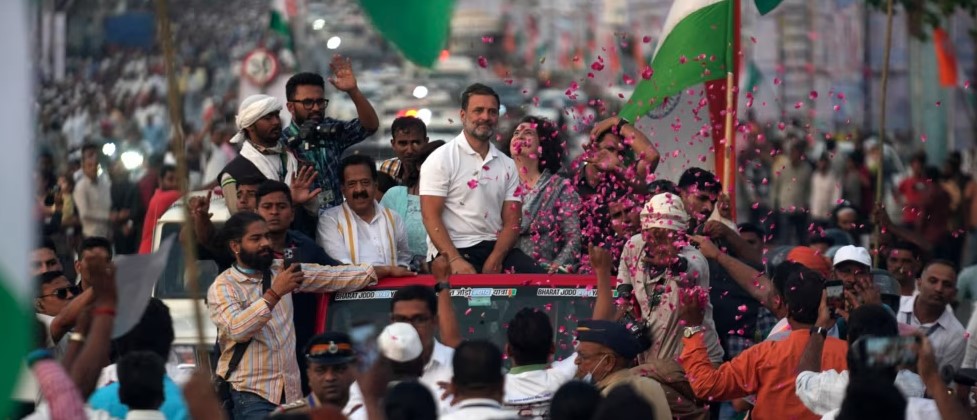0%

Rahul Gandhi, a senior leader of India's main opposition Congress Party, center, and his sister and party leader Priyanka Gandhi Vadra, center-right, are greeted as they drive through Mumbai, March 16, 2024, during their "Unite India Justice March."/Reuters
NEW DELHI: Traversing 6,600 kilometers through 15 states over the last two months, the leader of India’s opposition Congress Party, Rahul Gandhi, beat out a message that the ruling Bharatiya Janata Party has failed to deliver economic and social justice for the country’s masses.
Gandhi’s “Unite India Justice March” that ended in Mumbai on Saturday aimed to give his party a boost ahead of general elections that begin on April 19.
At dozens of roadshows, he said government policies have benefited business tycoons, not the marginalized masses. He promised his party would address issues such as joblessness, especially among educated youth.
Pledging to enact a “Right to Apprentice Act” if voted to power, Gandhi said that “we will ensure that every person getting a diploma graduating from college will get a one-year job as an apprentice” and earn the equivalent of $1,200 a year. He said the plan will change the “destiny of the youth.”
He also pledged to fill vacancies for three million government jobs.
But can such promises dent the popularity of Prime Minister Narendra Modi, who according to most recent surveys will win a third term in office?
“[Gandhi] is seen as a symbol for all those dissatisfied with the Narendra Modi regime,” according to political analyst Neerja Chowdhury.
“But his message, which is about the alleged corruption of the Modi regime, growing unemployment, rising prices and the hardships that people are facing, is not having the kind of traction at the ground level that one would have thought might have happened.”
That poses a challenge to the Congress Party’s hopes of weakening the BJP’s hold on power in parliamentary elections beginning April 19.
Congress, the largest opposition party in India, won just 52 seats in 543-seat lower house five years ago. BJP and its allies won more than 350.
“Beyond a shadow of doubt, Rahul Gandhi is raising the right issues,” said political analyst Sandeep Shastri, pointing out that recent data shows that unemployment and inflation are key concerns in the country.
“But will the right issues being raised convert into votes is a big question mark, because that is more a question of the voter perception of who is capable of solving the problem.”
At public meetings in recent weeks, Modi has pitched himself as a leader who can deliver results and has improved the lives of India’s poor during his ten years in power.
“We have opened bank accounts for the poor, helped them build concrete houses, and given them water, electricity connections and free vaccines,” Modi told a meeting in the southern state of Telangana, where his party is trying to make inroads. “There is only one guarantee of change, that is Modi’s guarantee.”
To counter the BJP, the Congress party forged an alliance with about two dozen regional parties last year to put up a united front to unseat Modi’s Hindu nationalist party.
But hopes of mounting an effective challenge to the BJP have dimmed as the opposition coalition called INDIA, an acronym for Indian National Developmental Inclusive Alliance, shows signs of fraying.
The alliance had aimed to put up a common candidate against the BJP to prevent splintering of votes in parliamentary constituencies which are often contested by multiple candidates. As a result, parties win elections even if they secure less than 50% of the votes cast.
However talks on seat-sharing have made limited headway in some states like West Bengal, where a powerful regional leader, Mamata Banerjee, decided that her party will contest all seats.
“It is a lost opportunity. Some of its big leaders have left the INDIA alliance, some other big leaders are not joining with the Congress and other parties to form a broad platform which was the whole idea,” says Chowdhury.
Analysts attribute the fissures in the alliance to the crushing losses that the Congress Party suffered in state elections held in December. The party lost power in two states, Rajasthan and Chhattisgarh and was unsuccessful in unseating the BJP in a third.
“It weakened the Congress Party’s role as the pivot of the alliance and subsequent to that, I think even state-based parties which were part of the alliance started redefining their individual strategies because they were more concerned with challenging the BJP in their individual states,” says Shastri.
Opposition parties also accuse the BJP government of weakening their ranks by using the country’s main financial investigation agency to launch probes against some of their leaders — charges the government strongly denies.
The stakes in the upcoming polls are highest for Rahul Gandhi. While most regional parties have been holding ground in states that they govern, the Congress Party has suffered two humiliating losses in the last two national elections.
Analysts say the opposition faces an uphill task in countering Modi — a strong, charismatic leader, who remains hugely popular amid a rising tide of Hindu nationalism.
“Gandhi has revived his image and tried to offer an alternative narrative, but so far many don’t see him as an alternative to Modi,” said Chowdhury.
The cross-country march by Gandhi was his second he trekked through 12 states over a year ago to connect with voters. It remains to be seen his efforts can resurrect the Congress Party that dominated India for seven decades, or whether it will continue to languish.
VOA